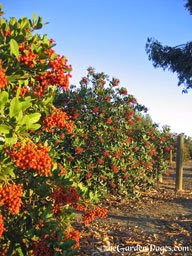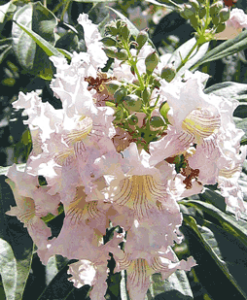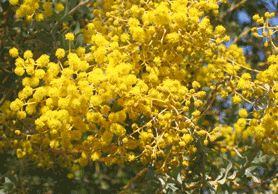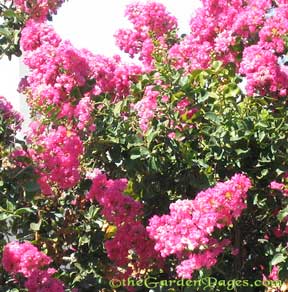Fall is just around the corner and for gardeners in the southwestern US, it is a great time to think about planting perennial, flowering shrubs. This is also a great time to plan out your landscape for next year, including preparing for more drought! Benefits of planting in autumn is a little extra free water from the rain, and milder temperatures for your new transplants to get established.
You can still grow beautiful trees and shrubs in a low-water garden. Here are a few of my favorite flowering shrubs. They all have beautiful blooms and are all drought tolerant too. I have written about them before, so I’m providing a quick rundown of the basics and a link to longer articles about each plant. Happy gardening!
 Toyon or California Christmas Berry
Toyon or California Christmas Berry
USDA Zone: 7 – 10
Sunset Zone: 5-9, 14-24
Height: 25 feet. Good screen shrub
Flowers: White, followed by festive red berries
Toyon is also called California Christmas Berry or Christmas Holly or Heteromeles arbutifolia. These beautiful shrubs are prized for their bright red berries and deep green leaves.
Toyon grows to about 25 feet tall and almost as wide. They make good screen shrubs for dry gardens, but you can also trim them into multi-trunked trees or standards. They have white flowers which are attractive to bees, but the show stopper comes just in time for Yule when the bright red berries ripen against the green leaves. See more photos and read more about Toyon…
 Chilopsis or Desert Willow
Chilopsis or Desert Willow
USDA Zone: 7 – 9
Sunset Zone: 3B, 7 – 14, 18 – 23
Height: 30 feet tall. Unique flowers and growth habit
Flowers: White, pinks and purples
Chilopsis linearis, or Sweet Desert Willow make a great alternative for traditional flowering cherry trees in dry gardens anywhere in the western US. The exotic flowers can appear from spring to fall and drip in giant clusters. Each flower can be about three inches long and an inch wide with colors ranging from white or pastel pink to hot pinks or deep purple. Like cherry trees, they are deciduous, but Desert Willow develop exotic seed pods with cottony down before giving up for the winter. They can be left as large shrubs, or trained into multi-trunked trees.
Desert Willow requires little to no water once they are established; only 10 inches according to the USDA. Desert Willow can grow up to 30 feet tall and up to 20 feet wide and are hardy to 3 degrees. Their shiny leaves are thin and up to 5 inches long, with the traditional willow look. The shrubs are pretty even when they are not in bloom. See more photos and read more about Desert Willow …
 Acacia
Acacia
USDA Zone: 7 – 10, depending on species
Sunset Zone: Depends on species
Height: 20 feet tall, as shrub or tree
Flowers: White, cream to yellows
Acacia trees can grow up to 20 feet tall. They are drought tolerant and most varieties are evergreen. Flowers are clusters of small powder puff flowers in colors from white to yellow. The bright yellow varieties are striking and bloom in the winter. Acacia tolerates heavy clay, alkaline soils. See more photos and read more about Acacia…
 Crape Myrtle or Lagerstroemia
Crape Myrtle or Lagerstroemia
USDA Zone: 7 – 10 depending on species
Sunset Zone: Most hybrids 7 – 10, 12 – 14, 18 – 21
Height: 30 feet tall as shrubs or small trees, good fall leaf colors
Flowers: White, creams, pinks, purples either pastel or bright
Crape Myrtle: Their Latin name is Lagerstroemia and the most common kinds sold here are l. indica or a hybrid of l. indica and l. fauriei (Japanese Crape Myrtle). They are also called Crepe Myrtle, or Crapemyrtle. These deciduous trees can bloom anytime from spring through fall. Colors come in bright white, dusty pinks, neon reds onto pink and purple shades, plus everything in-between.
Lagerstroemia can grow up to 25 feet tall and in the fall their leaves change color into deep oranges and reds. They do well in hot weather and withstand some drought once established. Crape myrtle has smooth, tan bark that can peel off in sheets and provides visual interest even when it doesn’t have leaves. These plants can be left as shrubs for a border or screen, or trained into standards or multi-trunked trees. See more photos and read more about Crape Myrtle…